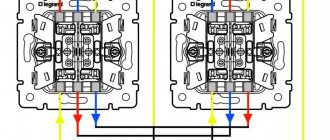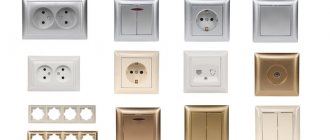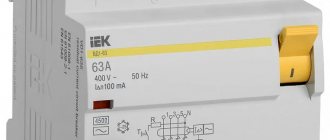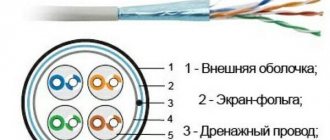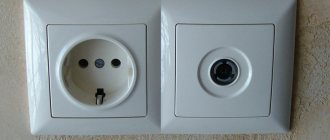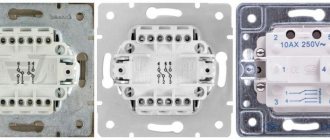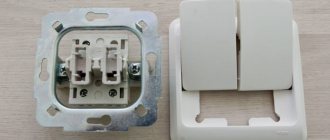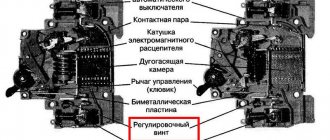In many residential and non-residential premises, where there are corridors, staircases and simply large rooms, standard switches can be inconvenient and impractical. The use of pass-through switches, which significantly simplify lighting control and the ability to turn lights on and off from different places, becomes the most optimal solution.
Lezard switches: consumer opinion
Reviews about devices from this manufacturer, as already mentioned, are relatively good online. The advantages of products supplied to the market by Dernek GROUP include, first of all, its wide range. The advantages of the Lezard brand sockets and switches themselves are:
- stylish appearance;
- reliability and long service life.
In terms of build quality, most home craftsmen compare the products of this company to similar products made in China.
The disadvantages of devices from this manufacturer include, first of all, the fact that rather thin plastic is often used to assemble their cases. Equipment of this brand must be handled carefully during installation and operation.
Another disadvantage of Lezard sockets is that the contacts in them are secured with screws. The wire in such structures can, unfortunately, be pinched literally to the point of breaking off. Some batches of products supplied by Dernek GROUP may sometimes contain non-working defects.
How to connect a Legrand Valena switch
An important element of any modern home are special devices that allow you to control energy sources; one of such devices is a switch. This part of the electrical network must be highly efficient and reliable, because it has to work in a fairly intensive mode.
Today, home improvement equipment manufacturers produce many types and types of switches. At the same time, according to reviews of many property owners, the best devices of this type are produced by the French company Legrand.
In addition to high functionality, Legrand switches also have an excellent design, which allows them to easily fit into the interior of literally any home. This article will discuss the features of the Legrand system, as well as methods for correctly installing such switches. A wide selection of Legrand Valena switches and mechanisms is presented here.
Switch 2x1-pole Legrand Etika 672204.10A, white
- White color
- line: Etika
- installation: hidden
- backlight: yes
- switch connection diagram: 2x1-pole switch
- wire connection type: screwless (clamping)
- device width 75.8 mm
- device height 75.8 mm
- device depth 43.65 mm
- Material property: thermoplastic
- material: plastic
- protection class: IP20
- protective surface coating: untreated
- number of keys 2
- type of equipment: mechanism with escutcheon
Average rating Switch 2x1-pole Legrand Etika 672204.10A, white - 3.17 A total of 6 reviews are known about Switch 2x1-pole Legrand Etika 672204.10A, white
Are you looking for positive and negative reviews about 2x1-pole switch Legrand Etika 672204.10A, white?
From 11 sources, we collected 6 negative, negative and positive reviews.
We will show all the advantages and disadvantages of 2x1-pole switch Legrand Etika 672204.10A, white, identified during use by users. We do not hide anything and post all positive and negative honest customer reviews about 2x1-pole switch Legrand Etika 672204.10A, white, and also offer alternative analogue products. Whether it’s worth buying is up to you to decide!
Types of crossover and pass-through switches
Let's take a closer look at the subject of our interest. First, we will study the existing options, and then we will learn how to connect them to electrical wiring.
In appearance, changeover switches vary in color and shape, and they also come in:
- hidden or open installation;
- single-key, two-key, three-key;
- with or without backlight;
- a special character on the keys may or may not be present.
Considering the internal diagram, we can talk about the following types:
- Single-key pass-through switch. It is most often used as the first and last device in the case of 2 or more control points.
- Pass-through switch with two keys. A double device is used for the same purpose to control lighting using 2 groups of lamps.
- 3-key pass-through switch. Used for the same purpose to control three groups of lamps.
- Single-key cross or toggle switch. Used as an intermediate device in a chain of three or more locations.
- Two-key cross switch. Used as a middle device in a chain of 3, 4 or more control points for two groups of luminaires.
As follows from the illustration above, in a pass-through switch, the input terminal is connected to one of the output terminals when the key is pressed. In crossover - the conductors connected to the input and output change places when the position of the key changes.
There's no point in worrying about internal circuit diversity at this point. Firstly, most often only a single pass-through switch is in demand. Secondly, something else may be required, and this will become clear from the specific options for connecting devices.
The photo shows a rear view of the wiring accessories. Now you can choose and purchase the right model yourself. Unfortunately, not all manufacturers indicate the contact markings on the device body. If it is missing, you will have to use a multimeter to determine the placement of the product terminals.
Information about the company and products sold
Legrand crossover switch Valena Life Legrand is a company from France, whose headquarters are located in the small town of Limoges. The specialists and engineers of this company have been producing electrical products for many years. In recent years alone, Legrand has significantly expanded its business through the acquisition of other companies in more than 60 countries.
Historical reference
The company's founding date is considered to be 1866, when its specialists opened the production of table porcelain. It was only in 1904 that this company was headed by Frederic Legrand, after whom it was named.
With the discovery of electricity, porcelain components began to be used to make switches and other electrical products, which began to be in great demand.
Product characteristics
Legrand Celiane Among all the diversity on the Russian market, two brands of this company stand out, which are usually considered separately. The first of these is Legrand Celiane, a branch of the company that produces premium switches. They are available in a wide range of different colors, ranging from white, graphite, titanium and all the way to ivory. These products are distinguished by their stylish design, elegant rounded shapes and the ability to fit into any modern interior.
The range of this range includes the following models:
- contactless (silent) switches;
- sensory devices;
- walk-through products;
- single-key and two-key samples;
- devices with backlight or indication.
According to their design, they can be with switches in the form of a button or with special levers. Today, these models are increasingly used as elements of a “Smart Home” and are truly unique devices that have no equal.
Products from Legrand Valena differ only slightly from the models already discussed and are also characterized by the perfection of lines and shapes. Their model range is so extensive that the most demanding buyer will be able to select electrical installation products suitable for a specific interior.
Popular series and classification
Legrand Valena Life
Legrand offers consumers a large number of different switches. All of them are divided into series, which differ from each other both in functionality and appearance. The most popular series among them are:
Valena and Valena Life are one- and two-key switches and switches of a classic (square) shape, made in the colors “aluminium”, “white”, “ivory”. Some models are equipped with backlighting. Products from the Valena Life series are distinguished by the gracefully curved shape of the keys, which allows you to turn on the light with a light touch of your finger. Galea Life - waterproof models included in this series of one- and two-key products, are distinguished by a strict design and original colors (dark bronze, titanium, mother-of-pearl, etc.). Many of them are equipped with backlight or indication.
GeaLine is a series of exquisite models of an expanded range (premium class). They are produced in the colors “white graphite”, “ivory”, “titanium” and are characterized by an original combination of square frames and rounded keys
What also attracts attention is the fact that genuine leather, porcelain, wood and glass are used for decoration. Quteo – a series of one- and two-key switches and switches designed for external installation on a wall surface (overhead). Impact-resistant ABS plastic is used to make their body. Plexo - a series of waterproof one- and two-key overhead models
They are installed in utility rooms (garage, basement, etc.) with high humidity (protection class IP55 or IP66).
Cariva is a series of inexpensive one- and two-key models designed for installation in offices and residential premises. Some of them are equipped with backlight. Waterproof versions are also available. Etika is a series of economical switches, the external parts of which are made of plastic. Available in one- or two-key versions. Their distinctive feature is the absence of a terminal block - the wires are fixed using a special nut.
All Legrand switches and switches are classified according to their functional purpose, type of installation and control method.
Switches Legrand
Based on their functional purpose, the following groups of products are distinguished:
- Switches are devices equipped with one or more pairs of contacts. When on, these contacts are closed (lighting is activated), and when off, they are open (lighting is off). As a rule, switches open only the contacts to which the phase wires are connected, but there are also two-pole options - in them the contacts also break the neutral (“zero”) wire.
- Switches are devices that use three or more contacts. In the “On” position, the first and second contacts close together, and in the “Off” position – the first and third. Switches equipped with three contacts are sometimes called "dual-way switches." They are usually used in cases where lighting is controlled from two places.
- Cross switches are devices that switch two separate lines crosswise (when switching, phase and “zero” change places). Such switches are also called “intermediate” - in lighting control circuits they are installed between switches in two directions, which allows you to turn on light sources from three or more places.
- Circuit breakers are devices designed to protect light sources from overvoltage or short circuit.
Legrand series for surface installation
Based on the type of installation, switches/switches are divided into surface-mounted and built-in.
- Invoices are used with open wiring.
- Built-in ones are designed for use when laying electrical wires hidden. Unlike overhead models, their actuator is hidden in a specially made recess on the wall surface.
According to the control method, switches/switches are:
- push-button;
- sensory;
- keyboards;
- responsive to people's movements.
Legrand Celiane touch
The introduction of innovative technologies allowed Legrand developers to create actuators:
- activated by a light touch of the hand (touch type models);
- activating lighting when it appears and turning it off when there are no people in the room (devices equipped with infrared sensors).
Models with push-button control, which appeared relatively recently, are easy to use and can bring a certain originality and elegance to the interior of the room. However, their use will require some time for the user to get used to it.
Connection diagram
Depending on the application and purpose, feed-through devices can be connected in several different ways:
- Installation of key-type pass-through devices for controlling one light source from two places.
- Connecting a single-key switch to control a group of lighting lamps from three or more places.
- Installation of a two-key switch to control two independent light sources with one double device.
Before describing the connection diagram for a pass-through switch, let’s remember how a standard one works.
Connection diagram for a standard switch
Connection diagram for a standard switch: N – phase zero, which is connected directly to the lamp; L – the energized phase passing through the switch and ensuring the ignition of the light by connecting the contacts in the circuit. Switching off, accordingly, occurs when the voltage is interrupted. Distribution box is the junction of the main cable with the “branches” of lighting and current distribution.
Thus, a regular switch allows you to turn on/extinguish the light from one control point from one place according to the principle of interrupting/connecting current.
The pass-through switch has a slightly different principle of operation: it is equipped with three contacts (and a double switch of this type has six) and operates on the principle of switching from one contact of the circuit to another.
Connection diagram for a Legrand pass-through switch: N – the neutral wire is connected directly to the lamp; L – the energized phase is supplied to the lamp, alternately passing through the switches and, unlike a standard switch, the supply/disconnection of light occurs not due to the closure/connector of the circuit contact, but due to their switching.
Connecting a two-key pass-through switch. A two-key switch is a common type of pass-through devices. As a rule, it is used to turn on/off lights in two different rooms from one place. Often used in apartment buildings.
Essentially, these are two independent single-key devices connected in one housing. The phases of the devices are combined and operate on the “switching” principle. This means that the moment one key is supplied with power, the other interrupts the circuit and is disconnected.
Legrand two-key pass-through devices are equipped with two independent groups of contacts, due to which the keys work independently of each other - when you press one of them, the switch occurs from the upper lines to the lower ones, and the first do not have a final output, and the second are connected to another similar switch.
It follows that these devices have two independent groups of contacts: right and left. Now that we have clarified this point, it will be easier to understand how to connect this type of device.
The most popular models of this type of device are the legrand etika and valena series. Below you can see the connection diagram for a two-key pass-through switch.
Connection diagram for a two-key pass-through switch
Legrand Etika/Valena two-key pass-through switch. Connection diagram: the contacts of the right group are connected to each other by a jumper; the phase wire is connected to the second of them. The contacts of the left group supply current to two lighting devices independent of each other, and they should not be connected to each other.
Peculiarities
Let's take a closer look at what each switch from this company can boast of. To do this, you should consider the structure of this equipment. Like all switches, the Legrand product includes such elements as:
- The base on which all the parts are located and thanks to which they are attached to the wall or mounting box.
- Contacts and keys.
- Frame.
- Frame.
- Terminal blocks.
In order for the switch to be securely attached to the wall, the manufacturer makes its base from galvanized steel. The peculiarity of this base is that it is not deformable and has four special elongated holes for fastening. Fastening is carried out using screws. The shape of these holes makes it possible to adjust the position of the switch itself. That is, it can be tilted in different directions and centered.
This is very convenient when leveling it. Thanks to this base, the Legrand switch, which can be sold with a remote control, can be installed in any installation box. Depending on the model, the metal base may have some cutouts.
The main mechanism, the body of which is made of high-strength plastic, is attached to this plate. This plastic is polycarbonate. It is also used to create frames and keys.
A feature of most switches from this company is that the frames and key covers can be easily removed. To do this, the Legrand organization makes small grooves in them. A screwdriver is inserted into these grooves and used to remove the frame and key cover.
Helpful hint: mechanisms of the same series are the same and as a result, frames and keycaps with different colors can be used for the same mechanism.
This makes it possible not only to select the desired color at the connection stage, but also to change the color, as well as the appearance of the Legrand switch after a certain period of time.
Some series of switches provide for the use of frames that are made of porcelain, wood, and also covered with leather. As for the contacts, they are made of an element such as ArNi.
The advantage of this is that they do not contain cadmium. This element is known to cause contamination of contacts. As a result, their resistance increases and they begin to burn. Due to the absence of cadmium, Legrand switches are safer and last much longer.
We all clearly know that wires are connected to the switch. To make this connection very simple and, most importantly, reliable, the equipment is equipped with automatic terminals. All you have to do is strip the wire and insert it into these terminals.
It is noteworthy that in many models the terminals are placed at an angle of 35 degrees. And this simplifies the process of connecting wires. The terminals are quite durable and are designed for those copper and aluminum wires, the cross-section of which ranges from 1.5-4 square meters. millimeter.
Reverse side of the switch
It is worth noting that the professionalism of Legrand specialists did not stop there. On the back of the case they drew a special marker, which has a certain length and indicates how many millimeters of wire insulation need to be removed in order to make a quality connection.
In addition to the above-mentioned marker, Legrand specialists also put a connection diagram on the back of the switch, which also explains the principle of operation. Of course, this greatly simplifies the process of connecting the necessary wires.
Apparently, by applying such markings, the company takes care of those people who want to purchase, but do not know how to correctly install the Legrand switch; how to connect it is also a question to which they do not have an answer.
Another feature of many switch models from Legrand is that they can be equipped with a protection cover, backlight, dimmer, motion sensor, and also a microcircuit that can analyze remote control commands.
If we talk about backlighting, it is done using LEDs. They are very easy to replace. To do this, simply remove the key cover, pull out the unusable LED and insert a new one.
All the company's products are divided into series, they combine both one- and two-key switches. At the same time, many series have pass-through switches.
Comments:
I use this circuit on my stairs to turn off the lights when you walk along them. Very comfortably. Thank you for the article.
As for me, pass-through switches have outlived their usefulness. A motion sensor is very inexpensive, and its installation is much simpler, so the technology is outdated
Vyacheslav, just imagine, you installed a pass-through switch in the bedroom to turn off the overhead light after you went to bed. What will you replace it with? Motion sensor? So that at night, when you turn around, you have illumination throughout your bedroom?
In corridors and stairwells, the pass-through switch can easily be replaced with a motion sensor, but in other cases it’s unlikely. In fairness, it is worth noting that there are actually not that many such cases.
I wouldn't use Lezard - it's an unreliable Chinese knock off. But connecting it is a whole story of songs and dances with a tambourine. In the end you will change it to Legrand or ABB anyway
For the first time today I encountered Lezard's 2-key passed pass. After 2.5 hours I still haven’t connected it. Everything works without a switch. Not with them.
The most important thing in China, everything is through…. In paired pass-through switches, the switching diagram on the reverse side does not correspond to reality. Common pin 2 works with pins 1 and 4, 5 with pins 3 and 6. Pin numbering from the specified switching diagram
Anatoly! Thanks a lot! I racked my brains assembling switches. Well done Chinese...as usual)
And if you use a dialer, then you can solve any puzzle from the Chinese.
I also recently encountered the connection of a double pass-through, plus two intermediate switches (cross) lezard! ... I’ll tell you it was still those dances with a tambourine, because: the diagram on the switch itself does not correspond to reality
The diagram found on the Internet (precisely Lezard) is not entirely correct, that is, they work, but inserting two intermediate (crossover) switches into the middle did not work due to several wires being mixed up, and so only after checking all the contacts it became clear how and where to connect what and why it didn’t work before: we take two three-core cables (core color: F, S, K) in the distribution box, cut both “W” wires and connect one pair together and connect to it a phase that will go to one of the switches and connect We connect them to the middle contacts “2 and 5”, connect the other two “F” wires in the distribution box separately, connect them to one and the second lamp, and connect the other ends to the second switch to contacts “2 and 5”, respectively! Next, it is very important to connect the pair “c” and “k” from one cable to the contacts: “1 and 4” and “1 and 4” and the other pair “c” and “k” to the contacts: “3 and 6” and “3 and 6" (so that contacts: "3 and 1" are "k" and contacts "4 and 6" are "c" and so the connection on the back of the switch looks like this: bottom: 1-k, 2-g, 3-k, top: 4-s, 5-g, 6-s (important: 3 and 6 common cable and 4-1 common cable) now everything works and you can connect two intermediate (cross) switches (between pass-through) by pre-installing cable (between the pass-throughs) in a loop (in transit, not cut.) in the undercut and like this: we take it, we strip the wire and we see three wires: g, s, k
“g” is left uncut, but “c” and “k” are cut and connected to the intermediate (cross) switch to the contacts: “1-4” - “c” and “3-6” - “k”, where contacts are 1 -3 (“s-k”) is the input, and 4-6 (“s-k”) is the output. We do the same with the second cable and the second intermediate (cross) switch. ...with this sawn-off shotgun I was able to install two double pass-throughs and four intermediate (cross) Lezard ones.
Leave a comment Cancel reply
Fuel-free generator - a way to make money on illiteracy
Pros and cons of vertical wind generators, their types and features
Windmill for a private home - a toy or a real alternative
Power bank with solar battery - calculation for illiteracy
How to choose a solar panel - overview of important parameters
source
Features of this switch
Pass-through switch Legrand with two keys
It is worth noting that the pass-through switch from Legrand, the connection diagram of which is very simple, is made of materials that make its use not only long-lasting, but also safe.
These materials are galvanized steel and polycarbonate. Elements such as calipers, grips, and screws are made of galvanized steel.
The frame, body, keys and connection mechanisms are made of polycarbonate or ABS plastic. This means that for many years these elements will not crack or be destroyed by ultraviolet rays.
A notable fact is that the manufacturer produces keys, housing and frame in different colors and with different patterns. The lid can also be made from:
- Porcelain.
- Tree.
- May be covered with skin.
As noted in the instructions, the Legrand switch housing itself can have two types of protection:
- IP20;
- IP44.
IP44 housings protect all internal contacts from moisture. The switch itself is secured either with screws or with clamps.
An important feature of the Legrand one- or two-key pass-through switch is the presence of screwless CuZn15/X12 CrNi 177 clamps, which greatly simplifies the procedure for connecting copper wires. These clamps allow the connection of both single-wire and multi-wire flexible conductors
They are designed for wires that have a cross-section from 1 to 2.5 square meters. millimeters
These clamps allow the connection of both single-wire and multi-wire flexible conductors. They are designed for wires that have a cross-section from 1 to 2.5 square meters. millimeter.
Helpful tip: to insert the wire into the clamp, you need to remove 12 millimeters of its insulation.
An important point is that ArNi contacts do not contain cadmium. This element leads to contact contamination and premature destruction. Any disconnector model from this company can operate in conditions where temperatures exceed 5 and are less than 40 degrees Celsius.
It is also worth saying that the pass-through switch is designed for a current of 10 amperes. In other words, the power of lighting devices can be up to 2.2 kW.
Another feature that is an important plus is the presence of an indicator light in some models.
1-gang switch with backlight, white, 672203 Legrand Etika
- Manufacturer: Legrand
- 0 reviews
- Description
- Characteristics
- Video
- Reviews 0 ? '(' + product.reviewsCount +')' : »>>
Single-key switch 672203 Legrand Etika with backlight is mainly intended for controlling lighting circuits. As a rule, it is installed for bathrooms, toilets, kitchens and corridors. The mechanism is mounted in a standard installation box (socket box) using spacer tabs or with screws. Screwless contact clamps provide quick and reliable connection of wires. The increased contact surface area guarantees connection quality and minimizes losses.
LED backlight bulb is included in the delivery package. It does not cause flicker in compact fluorescent and LED lamps. Depending on the connection method, the lamp can work as a backlight or as an indication.
Download the technical data sheet for the switch.
Characteristics of switch 672203 Legrand:
Product type: switch Number of keys: 1 Rated mains voltage:
230 V, 50 Hz Rated current: 10 AX Switching power: 2300 W (for incandescent lamps) Illumination available: with LED backlight Terminal type: screw Terminal capacity: 2 x 2.5 mm sq. Dust and moisture protection degree: IP20 Cover color: white Article number: 672203 Series: Etika Manufacturer: Legrand
Installation of Etika series products:
Switch connection diagram (with backlight):
Flaws
Such switches also have a number of disadvantages that must be taken into account during installation.
Let's highlight the main ones:
- If you don't know the main differences, they can easily be confused with a regular switch.
- There is no precise position to detect the position (on, off). For example, when replacing a light bulb, it is difficult to understand whether the power supply to the device is suitable or not. For safety, it is recommended to turn off the power supply.
- There are many wires appearing in the junction box. Their number increases with the number of light bulbs. It is not advisable to connect devices directly, because in this case you will have to endure high costs. In addition, with a large number of lamps in one circuit, the use of pulse relays is provided.
- Higher price due to design features.
Features of switches
Legrand touch switch A feature of modern Legrand switches is the presence of samples that cannot be classified into any specific category. First of all, this is a single-key wall-mounted model, equipped with a control panel included in the switching device kit. The following samples belong to the same type of products:
- with a cord or button instead of a regular key;
- touch-sensitive light switches with electronic filling;
- two-key devices;
- Legrand pass-through switch.
The presence in the range of this manufacturer of touch models used with motion sensors significantly expands the scope of their application. The same is observed with Legrand pass-through switches, which allow organizing original switching circuits.
The demand for such solutions is explained by the need to turn on the light at the entrance to the room and turn it off when leaving it.
Device, principle of operation
Switches of this type are relatively simple devices through which it is possible to switch electrical circuits and control lighting fixtures. It is easier to consider their design and operating principle using the example of a single-key product consisting of the following main parts.
- switching module with built-in switching mechanism;
- special fasteners that allow you to fix the device in a wall niche (used for hidden installation);
- decorative body;
- control key.
The operating principle of a mechanical switch does not require detailed analysis, since in this case the operating contacts are simply closed and opened. A more complex option is a sensor device, for switching which an electronic filling is used that acts on an actuator relay. But even in this case, it all comes down to closing and opening the contacts through which power is supplied to the lighting device.
Pass-through switches
Pass-through switches are devices designed to provide control of a single light source from two or more different locations. In other words, with this scheme you will have two switches for one light bulb.
The main fundamental difference between pass-through switches and conventional single-key switches is the number of contacts. While single-key switches have two of them - for input and output, their walk-through counterparts have 3 contacts. Therefore, a pass-through switch, in its essence, is not a switch, but a switch that transfers an electrical circuit from one working contact to another.
At first glance, it may seem that walk-through switches work on the same principle as two-key switches, which also have 3 contacts. However, this is not entirely true: when one of the contacts of the pass-through switch is closed, the other one also closes, and it simply does not have a position in which both circuits are open. Both of these facts have nothing to do with two-key switches.
Pass-through switches can be not only mechanical, but also electronic, in particular touch-sensitive. Such models have a more stylish look and a wide variety of design solutions. Modern sensors are highly sensitive and trigger even before touching – you just need to bring your hand a few centimeters from the switch.
Pass-through switches
Pass-through switches may also provide the ability to turn lighting fixtures on and off using a remote control.
Areas of application of two-gang switches
Legrand two-key switch with backlight
To solve the problem of long corridors, the company has developed not only walk-through, but also so-called “cross” two-key models that are part of a three-point light control system. Before connecting Legrand switches of this type, you will need to understand their structure and circuit diagram. Both pass-through and crossover models from the Cariva, Life, etc. series have several groups of switched contacts, through which it is possible to implement the desired function.
When a key is pressed, each of the two mechanisms included in the switch set closes one of the connecting lines, simultaneously opening the other. The specified operating procedure allows for separate control of the lighting device using two different switches separated by a considerable distance.
The most obvious example of their use is the installation of one of the switches in the entrance vestibule at the entrance, and the second on each landing.
When entering a building, the user turns on the lighting on all areas with one button, and when approaching his apartment, turns it off.
Nuances of connecting switches from Legrand
Control from 2 places of two groups of lamps (double switch for 2 directions)
When considering the installation features of two-key switches from Legrand, special attention is paid to the following important details:
- according to the instructions for walk-through models such as Quteo, Etika and others, open or closed distribution boxes are used when installing them;
- to connect the wires, they use special “walnut” type clamps or they are fastened with screws included in the package of each product;
- Before installing the switch in an open design, a plastic or wooden base is prepared for it, on which it is convenient to mount the housing.
If it is necessary to remove the backlight from the switch, it is better to do this before installing it.
Before installing pass-through switches from the “Ethics” series and the like, it is necessary to thoroughly prepare for work operations. To do this you will need:
- remove the decorative frame and keys from the case - they have special grooves;
- insert a screwdriver with a thin tip into the groove, and then press firmly in the desired direction;
- remove the frame of the product in the same way.
Upon completion of all preparatory operations, the circuit breaker is completely ready for installation.
Direct installation
Disabling a common water machine before installing a switch
It is recommended to install walk-through products in the following order:
- Before installing each of the switches, the power supply is removed from the line - the input circuit breaker is turned off.
- The housing of the first switch is placed in the installation box and securely fixed in it.
- Already laid conductors are connected to its contacts on both sides, which are connected according to the attached instructions.
- The same operations are performed with the second switch.
At the final stage of installation work, the decorative frame and double key are returned to the already installed devices.
The Legrand two-key switch is no different from a conventional keyboard device. Well-known models of this device Life, Quteo or Valenon are integrated with household electrical wiring in exactly the same way as domestic products. Problems associated with the peculiarities of their installation can be easily solved after reading the instructions for use.
Installation procedure for conventional Legrand models
Technique for removing insulation from wiring
Before installing the Legrand switch in the usual version, you should prepare the simplest tool: a screwdriver, side cutters and a sharp knife.
Installation procedure for two-key models:
- The input machine is turned off.
- The conductors supplied to the product are prepared for connection - the insulation at their ends is stripped.
- The keys and decorative cover are removed from the device.
- Next, you can connect the stripped ends of the conductors to its terminals, and then return the decorative frame and keys to their place.
When installing double switches from Legrand, special attention is paid to the distribution of outgoing wires. Each of them is designed to connect a separate load located within the serviced premises. When installing the product, you must take into account the markings on its body, indicating the connection points of the incoming and outgoing single cores of the cable.
Pass-through switch
Any electrician knows that conventional switches operate on the principle of interrupting the current circuit. Transition models differ from them in this regard, since they are equipped with three contacts that allow the device to be switched. In turn, the double pass-through switch has 6 similar contacts.
Among the advantages that transition switches have, the main one is that they can be used to turn off and turn on lights from different places.
Scope of application of pass-through switches
Modern pass-through switches have become widespread in several areas:
- Stairs. A prerequisite for them is that switches must be installed on the first and second floors. This will make it possible to turn on the light on one of the floors, after which, when a person goes up or down, he can turn off the light using another walk-through switch.
- Sleeping rooms. In these rooms, switches of this type are installed at the entrance to the room and next to the bed. This option provides a lot of convenience, since a person does not have to get out of bed and go to the entrance to turn off or turn on the light.
- Corridors. Pass-through switches are especially convenient for long corridors, since they can be installed at the very beginning and at the end.
- Dachas. Here, the benefit of using transition switches is that the owner has the opportunity to provide lighting to the yard and paths.
Pass-through switch: connection diagram
If we consider the principle of operation of a pass-through switch, then this is similar to switching railroad tracks, since they begin to work regardless of what position they are switched to. The fact is that switching from one line to another is used here.
If we consider in more detail the connection diagram of the pass-through switch, it is as follows. There are two switches, where one is supplied with phase, from the other it is transferred to the lamp, the connection between them is provided by a special wire or cable. However, most often they are left disconnected, since here the option is used with a distribution box in which they are placed, while three wires are taken from each switch, of which two are connected to each other.
There are cases when more wires can be connected to the transition switches, but the connection diagram remains the same. True, there will still be certain differences here, namely that the first two cables will provide only one input contact and two output contacts. By increasing the number of cables, the owner will be faced with the need to increase the number of input and output contacts, which will have to be increased to two. Such a solution will allow you to create a cross connection of two lines.
Installation of sockets and switches
Sockets and switches are installed after wallpapering or painting the walls. Installing sockets is one of the last jobs performed during a renovation.
It goes without saying that the electricity should be turned off. That is, turn it off exactly in the room in which work will be done to install sockets and switches. This can be done by finding the appropriate machine in the electrical panel. If you don’t know which machine turns off the electricity supply to the room, you can determine this experimentally by turning off the machines one by one and listening to where the cries of “TV doesn’t work!” or “turn on the bathroom light!” This method will allow you to accurately determine the connection of each of the machines with a specific area of the apartment. If there is no one else in the apartment except you, then you will have to do it differently.
Turn off all machines. Expose the wires in the socket boxes and switch in the room where the installation needs to be done. Now, turn on the machines one by one and, armed with an indicator screwdriver, check which machine, when you turn on, the indicator on the screwdriver lights up when it touches the phase wire.
